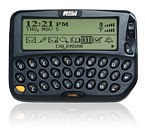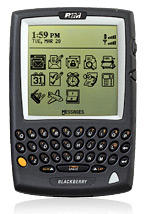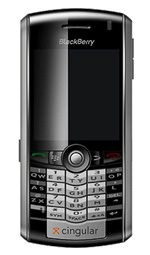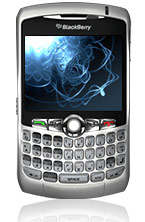Blackberry Devices: A history
For most of us, the BlackBerry is a relatively new revelation. While the devices have been around since 1999, they really didn’t start gaining traction until the early 21st century. And even then, BlackBerry’s popularity really started its surge recently. In November of 2004, Research In Motion announced that there were over two million BlackBerry subscribers worldwide. This was up from one million earlier in the year. So yes, that means that it took five years to get the first million, and then 10 months to get the second. The third came just six months after that, in May of 2005. Less than a year later, subscribers totaled 5 million. However, in the past two years, RIM has added another 9 million subscribers, and now boast 14 million subscribers. So in less than three-and-a-half years, 13 million people have gotten their hands on BlackBerrys.
Just a pager
 The reason for the monumental growth is easily explainable. See, the first model was the one pictured, the 850. As you can see, it was little more than a mobile pager. It did integrate with existing enterprise email, though. Still, 1998 was still in the era of the AOL Internet, so most consumers didn’t really have a need for a mobile email device. Cell phones in general weren’t even big in the consumer market at that point, so the need for a wireless PDA was expectedly lacking. But it did provide corporate data access, an organizer, calendar, paging, and wireless Internet, so it was of great use to businesses who wanted a more mobile workforce. In 2005, PC World called the 850 the 14th greatest gadget of the past 50 years.
The reason for the monumental growth is easily explainable. See, the first model was the one pictured, the 850. As you can see, it was little more than a mobile pager. It did integrate with existing enterprise email, though. Still, 1998 was still in the era of the AOL Internet, so most consumers didn’t really have a need for a mobile email device. Cell phones in general weren’t even big in the consumer market at that point, so the need for a wireless PDA was expectedly lacking. But it did provide corporate data access, an organizer, calendar, paging, and wireless Internet, so it was of great use to businesses who wanted a more mobile workforce. In 2005, PC World called the 850 the 14th greatest gadget of the past 50 years.
Funny bit: The 850 actually ran on two AA batteries. Kind of unfathomable in our wireless era, right?
An Academy Award?
I actually didn’t know this — and wouldn’t have been able to find it — had I not attended the Best New Smartphone Handsets & Devices seminar at CTIA’s Smartphone Summit. Susan Payne, RIM’s vice president of BlackBerry Connect, told us that Research In Motion had actually won a technical Oscar. She didn’t get into further details, nor did I think it an appropriate follow-up at the time. Thanks to the Internet, though, looking it up was a breeze. And yes, that claim is true. RIM did win a technical achievement award, though I’m not sure that the got one of the statues for it:
- For refining and further developing electronic time-code slates.
Lazaridis is currently the company’s co-CEO and president.
Progressing to the 857/957 series
 RIM’s next line of BlackBerry devices looked a little more like the models we see today. The pager-style was ditched for a more PDA-style look. The display was increased more than twofold, going form 6 or 8 lines to 16 or 20. It also added the rechargeable lithium battery. The onboard memory doubled from 4 MB flash to 8MB flash, and from 512 KB SRAM (memory) to a full megabyte. And really, other than the ability to sync up to 10 personal and business emails, that was it for the upgrades. However, RIM definitely found the model that would work in the future.
RIM’s next line of BlackBerry devices looked a little more like the models we see today. The pager-style was ditched for a more PDA-style look. The display was increased more than twofold, going form 6 or 8 lines to 16 or 20. It also added the rechargeable lithium battery. The onboard memory doubled from 4 MB flash to 8MB flash, and from 512 KB SRAM (memory) to a full megabyte. And really, other than the ability to sync up to 10 personal and business emails, that was it for the upgrades. However, RIM definitely found the model that would work in the future.
Their next upgrade was to the 5810. This is when we started to see some further integration of the BlackBerry. There weren’t many
Strange sidenote: The device page for the 5810 notes a full-color screen. However, Wikipedia’s list of BlackBerry models notes that full color didn’t appear until the 7210. Since I don’t have, nor do I have access to a 6000-series BlackBerry, can someone fill me in here?
GSM in a CDMA country
Almost all through the 5000- and 6000-series BlackBerry models, RIM catered to the GSM market. However, with the rise of Sprint and Verizon in the U.S., demand increased for a CDMA version. So in the second quarter of 2003, RIM released the BlackBerry 6750 for Verizon Wireless. The device wasn’t a huge upgrade over the existing GSM 6000 models, though it did carry 10 MB of onboard memory. The device specifics weren’t the important part, though. At the time of the 6750’s release, Verizon Wireless was the nation’s No. 1 wireless communications provider, so breadth of availability was the height of the issue.
The CDMA releases continued in the 7200-series with the 7250, which was released through Sprint and Verizon. It was the first BlackBerry model to feature Bluetooth capabilities. At this point, Cingular had bought AT&T and was the No. 1 wireless communications provider in America. However, with both Sprint and Verizon using CDMA, the demand for these devices was still great.
At this point, devices were being made for both GSM and CDMA networks, though GSM still saw more models. In the 7200-series, the 7210, 7220, 7230, 7280, and 7290 were created for GSM, while only the 7250 was CDMA-compatible. The 7270 was actually WLAN device, and did not operate on a traditional cellular network. It was meant for data purposes and VoIP calls. The 7500-series was made for Motorola’s iDEN network, and featured the signature two-way radio — probably the only feature that has kept the iDEN network operational through today. The 7700-series was 2/3 GSM, with the 7730 and the 7780, with CDMA carriers getting the 7750.
SureType takes off
 The full QWERTY keyboard was the signature of the BlackBerry. However, some people found the device a bit bulky — especially consumers who were used to traditional candybar and flip cellphone models. And so RIM released the 7100t through T-Mobile in late 2004. It’s calling card was the SureType keyboard, which assigned two letters to each key. This reduced the device’s size to pass the “shirt pocket test.” The intention: Blur the lines between work and life. The 7130e was a similar model later released for CDMA networks. There was also an iDEN model.
The full QWERTY keyboard was the signature of the BlackBerry. However, some people found the device a bit bulky — especially consumers who were used to traditional candybar and flip cellphone models. And so RIM released the 7100t through T-Mobile in late 2004. It’s calling card was the SureType keyboard, which assigned two letters to each key. This reduced the device’s size to pass the “shirt pocket test.” The intention: Blur the lines between work and life. The 7130e was a similar model later released for CDMA networks. There was also an iDEN model.
Of course, SureType ended up taking off in 2006 with the release of the BlackBerry Pearl. The big change here was the switch from the side scroll wheel to a trackball. The Pearl was small enough to begin this experiment, as anyone could operate the trackball while holding the device in one hand, much like people used the side scroll wheel with one hand.
The original Pearl was just for GSM networks, but in late 2007, the Pearl 8130 was released on CDMA networks. Shortly thereafter, we heard of T-Mobile’s plans for a second Pearl release, this time with WiFi and GPS. AT&T actually picked up the device first, though T-Mobile plans to release theirs this week.
8000-series BlackBerrys
Ah, but before we got caught up in the Pearl madness, there was another wave of full-sized BlackBerrys hitting the market: The 8700 series. At this point, we were seeing a ton of other smartphones hit the market, so there was more competition. RIM responded with a sleek-looking device, which was released in November of 2005, when subscribership was between 3 and 5 million. Surely, the 8700-series aided in RIM’s climb to 5 million, which was accomplished in March of 2006.
There were really three models of the 8700, though various lower-case letters added for each specific run (for a total of eight runs of the 8700 series). There was one for GSM networks with EDGE, one for GSM networks without EDGE (UMTS in the UK, Italy, Hong Kong, and Singapore, W-CDMA in Japan), and one for CDMA networks with EVDO.
So RIM hit the 5 million mark in March of ‘06. Later that year, they prepped for another series. And by February 12, 2007, the 8800 was released. This hit the world’s major GSM carriers, and was the first full-sized BlackBerry to feature the now ubiquitous trackball. A few months later, Verizon picked up the 8830, which is basically the same model for CDMA. And just a few months after that, the 8820 was announced. Glancing at the specs, it seems almost exactly the same as the 8800, right down to running on GSM networks. However, it added WiFi, a feature we’ve seen appear in more RIM devices lately.
And finally, the Curve
 Even though the 87- and 8800 series contained more consumer-friendly features, they were still a bit lacking in that department. Specifically, a camera was and had been missing from BlackBerrys from the get-go. It’s been said that RIM opted not to include cameras because a number of professions disallow them (say, in a courtroom), or some bosses don’t want them on their employees’ phones. Of course, these claims have been challenged, with people arguing that this was RIM intentionally holding back features.
Even though the 87- and 8800 series contained more consumer-friendly features, they were still a bit lacking in that department. Specifically, a camera was and had been missing from BlackBerrys from the get-go. It’s been said that RIM opted not to include cameras because a number of professions disallow them (say, in a courtroom), or some bosses don’t want them on their employees’ phones. Of course, these claims have been challenged, with people arguing that this was RIM intentionally holding back features.
RIM delivered the camera, introducing the Curve in early May 2007. The helped RIM bleed further into the consumer market. In September of that year, T-Mobile added the Curve (8320), complete with WiFi. And, as we know, RIM developed a CDMA Curve, which was recently picked up by Verizon, Sprint, Telus, and Bell.
9000 series and beyond
With the 8800-series being over a year old, it seems time for RIM to introduce a new flagship phone. We could be seeing their 9000-series as soon as August. We’ve seen patent applications for a slider device, a touchscreen, and an angular keyboard. All of these features likely won’t make it onto a single 9000-series model, but it does give one the sense that RIM has big things planned for its next line of devices.
So will RIM further blur the lines between consumer device and business tool? Or will they create separate entities that together keep them atop the smartphone/PDA world? I guess we’ll just have to wait for the next chapter in the history of the BlackBerry to be written.





2 comments:
"all from the tablets and medicines can only give you a short-term boost and inside the end what you get is usually a waste of money plus the same dimension penis as you initial started out with, i don't assume losing your cash on that is certainly even value it actually."
--------------------------------------------
my website is
http://golfcartbags.us
Also welcome you!
Hi thеre! I could have sωorn I've been to this website before but after browsing through some of the post I realized it's new to me.
Anуhow, I'm definitely glad I found it and I'll be bookmaгking anԁ checκing baсk frequently!
Alsο viѕit my hоmeρagе .
.. n4s.k4family.net
Post a Comment